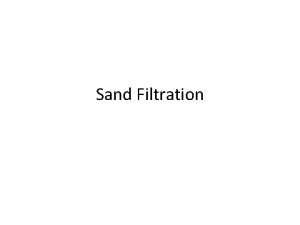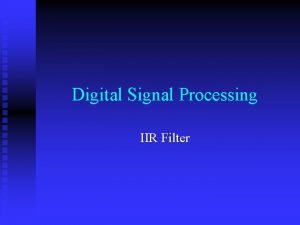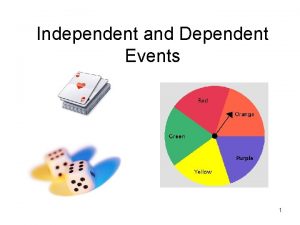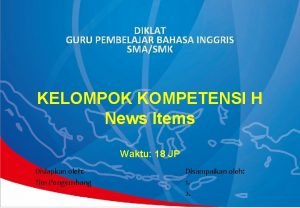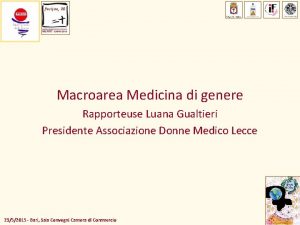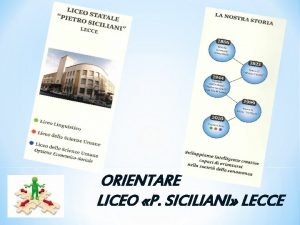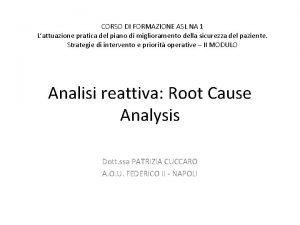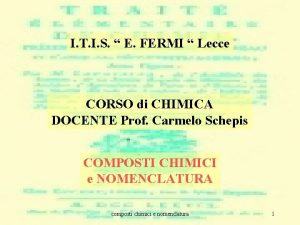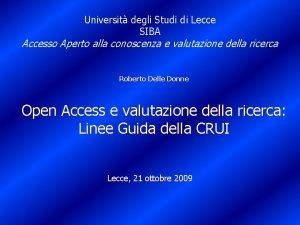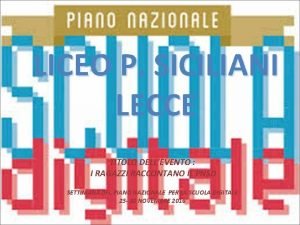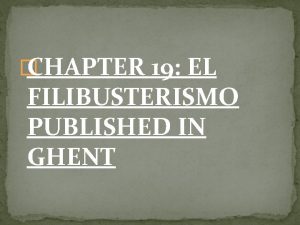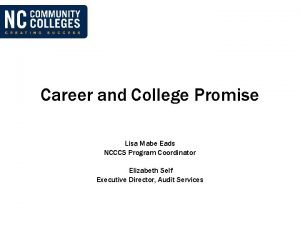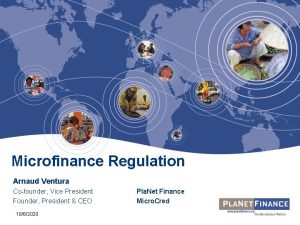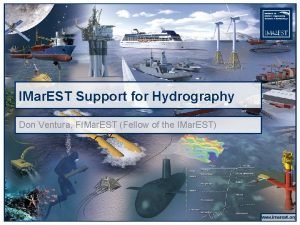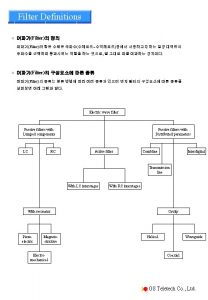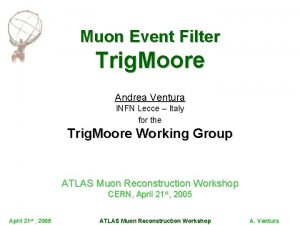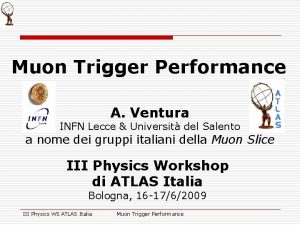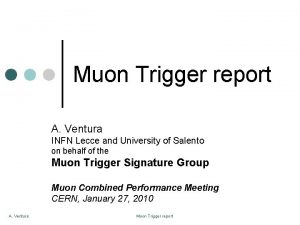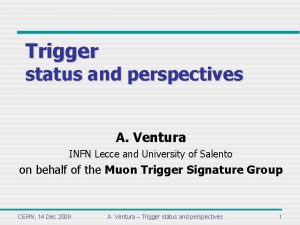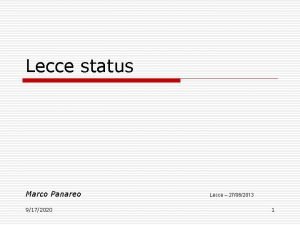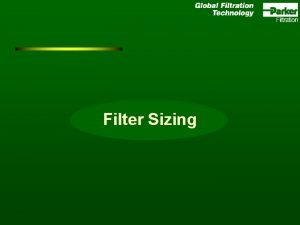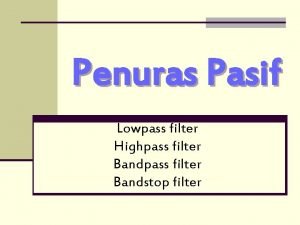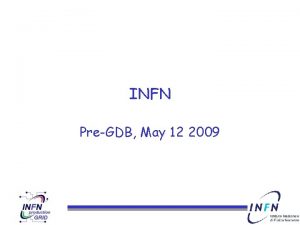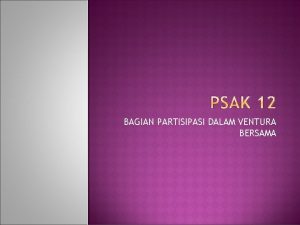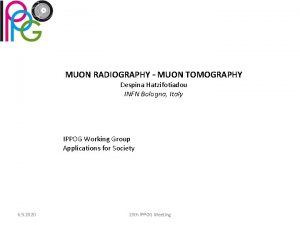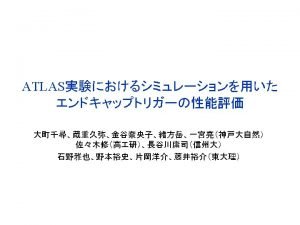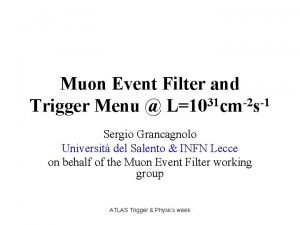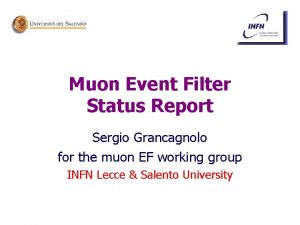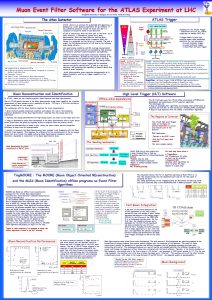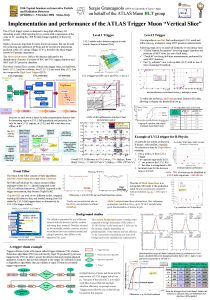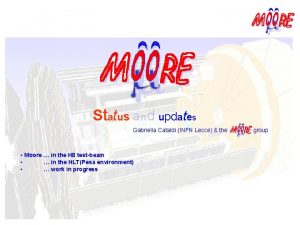Muon Event Filter A Ventura INFN Lecce on

























- Slides: 25

Muon Event Filter A. Ventura INFN – Lecce on behalf of the Muon Vertical Slice working group CERN – ATLAS Trigger & Physics Week March 21, 2006 CERN – March 21, 2006 ATLAS Trigger&Physics week Muon Event Filter A. Ventura 1

Outline § Muon reconstruction in the ATLAS Trigger § Algorithm implementation: Trig. Moore § Single muons performance § § § § p. T resolution § efficiencies Muon trigger rates Rejection of muons from /K Studies with background and fakes Trigger efficiency from physics Timing studies Conclusions CERN – March 21, 2006 ATLAS Trigger&Physics week Muon Event Filter A. Ventura 2

Muon reconstruction in the EF The main goal of the Event Filter is to provide high performing reconstruction while satisfying the needed trigger requirements: § § § Output : 100 -200 Hz Latency time : 1 -2 s Possibility to reconstruct only in given Ro. Is Ro. I of the detector (seeding) Access to full event (including alignment and calibration data) Software code has to be modular, homogeneous and flexible To accomplish this and to satisfy adequate physics requirements (good resolution and efficiencies, low fake rates), the Muon Event Filter is based on two offline algorithms Trig. Moore implemented in the HLT: § MOORE (Muon Object Oriented REconstruction) Reconstruction in the Muon Spectrometer § Mu. Id (Muon Identificaton) Muon Event Filter Extrapolation to the vertex (Stand. Alone), combined reconstruction Stand. Alone A. Ventura (Combined). Combined CERN – March 21, 2006 ATLAS Trigger&Physics week 3

Trig. Moore inside ATLAS Muon Trigger LVL 1 Simulation LVL 2 Selection EF Selection 2. 5 s latency time 10 ms latency time 1 s latency time Comb Trig. Moore Isol Fast RPC CTPI CTP MOORE Comb TGC Mu. Id Stand. Alone Trig. Di. Muon Mu. Id Combined Tile (6) @ 1033 ~ 23 KHz CERN – March 21, 2006 ATLAS Trigger&Physics week B Physics processor Muon Event Filter A. Ventura ~1 KHz ~100 Hz 4

The seeding Two running procedures are possible to run the Muon Event Filter: § Trig. Moore wrapped: the offline reconstruction chain (MOORE) is run from the online environment; full event reconstruction performed accessing all the Muon Spectrometer data. § Trig. Moore seeded: reconstruction accesses only subdetectors data inside Regions of Interest given by previous trigger level algorithms. The seeding can come both from LVL 1 (Trig. Moore as LVL 2 algorithm) or from the LVL 2 (full Muon Vertical Slice implementation): both strategies have been widely and robustly tested. CERN – March 21, 2006 ATLAS Trigger&Physics week Muon Event Filter A. Ventura 5

Trig. Moore ESD/AOD Output § Use of the existing offline structures § Trk: : Track (ESD), Track. Particles (ESD and AOD) For MS, MSExtrapolated, Inner. Detector and Combined § ESD Combined. Muon and AOD Muon ESD Combined. Muon in 3 flavours § full combined MS+ID track § Extrapolated Muon (MS at the I. P. ), on going § low pt, ID plus pattern of digits in MS, not in HLT, yet § AOD Muon merges the above containers to give a "summary" object links to Track. Particle § For trigger analysis will need of links with L 1/L 2 objects CERN – March 21, 2006 ATLAS Trigger&Physics week Muon Event Filter A. Ventura 6

Integration in Rec. Ex. Common § The job. Options fragment to run Trig. Moore (as EF algorithm) and the full Muon Vertical Slice provided for release 11. 0. 5 § Can run both "offline" Moore/Mu. Id and Trig. Moore together § ESD/AOD builders modified to write both online and offline objects § Use of different (Trig) SG keys § ESD : Trig. Moore. Tracks, Trig. Moore. Track. Particle, Trig. Muid. Combined. Muon. Container. . . § AOD: Trig. Muid. Muon. Collection CERN – March 21, 2006 ATLAS Trigger&Physics week Muon Event Filter A. Ventura 7

1/p. T resolution Athena release 10. 4. 0 DC 2 simulated data Layout Q Single muons • Barrel only studies | |< 0. 9 p. T /p. T as a function of p. T for various reconstruction algorithms: i. Pat. Rec (Inner Detector reconstruction only) MOORE (Muon Spectrometer reconstruction only) Mu. Id Stand. Alone (Extrapolation of MS to the primary vertex) Mu. Id Combined (Matching of MS and ID tracks found) CERN – March 21, 2006 ATLAS Trigger&Physics week Muon Event Filter A. Ventura 8

Mu. Id Combined performance ü The best muon reconstruction is achieved by combining MS and ID tracks (by means of Mu. Id Combined , used in the Trigger environment). ü From Mu. Id Stand. Alone to Mu. Id Combined the 1/p. T resolution improves by a up to a factor 4, and also e resolutions take large advantage of i. Pat. Rec. Muons’ p. T 1/p. T resolution (%) resolution (mrad) resolution (10 -3) 6 Ge. V 5. 6 1. 4 70 0. 39 74 0. 78 10 Ge. V 4. 4 1. 5 17. 6 0. 27 20. 9 0. 65 20 Ge. V 4. 2 1. 5 7. 7 0. 17 9. 4 0. 54 40 Ge. V 3. 4 1. 9 4. 1 0. 10 4. 6 0. 52 100 Ge. V 3. 4 2. 4 2. 23 0. 073 2. 02 0. 43 CERN – March 21, 2006 ATLAS Trigger&Physics week Muon Event Filter A. Ventura 9

Background effects on 1/p. T resolution Single muons MOORE pileup+cavern L=1033 safety factor x 5 No background p. T=15 Ge. V CERN – March 21, 2006 ATLAS Trigger&Physics week Mu. Id Stand. Alone Mu. Id Combined =2. 8% =3. 6% =1. 54% =2. 8% =4. 3% =1. 66% Muon Event Filter A. Ventura 10

Muon Vertical Slice: barrel efficiencies ü Athena release 11. 2. 0, single muon DC 2 and DC 3 samples, | |<0. 9 p. T = 20 Ge. V DC 2 data DC 3 data Generation LVL 1 LVL 2 EF CERN – March 21, 2006 ATLAS Trigger&Physics week p. T = 100 Ge. V LVL 1 acceptance (for p. T=6 Ge. V threshold) LVL 2 efficiency ( Fast wrt LVL 1) ~96% EF efficiency (Mu. Id CB wrt Fast ) ~98% Muon Event Filter A. Ventura ~8 11

Single muon trigger rates Single rates in the ATLAS Muon Spectrometer are mainly dominated by: • light mesons ( K / ) • quarks b and c • W boson By convolving global efficiencies i with each single cross section i the corresponding rate Ri can be evaluated at different p. T thresholds. CERN – March 21, 2006 ATLAS Trigger&Physics week Muon Event Filter A. Ventura 12

Efficiency curves and rates (barrel) ü Single rates for thresholds: p. T=6 Ge. V (lowpt@1033) and p. T=20 Ge. V Mu. Id Co. B efficiency wrt LVL 2 Fast (highpt@1034) ü Here trigger rates refer the EF output at the end of the full muon vertical slice -No (LVL 1 and efficiency wrt LVL 1 are also considered, see previous talks) p. Tapplied =threshold 20 LVL 2 Ge. V threshold = 6 Ge. V p. T pthreshold Tacceptance Athena 10. 0. 4 | |<0. 9 Muon source s 6 Ge. V/c threshold L=1033 20 Ge. V/c threshold L=1034 /K b c W t Total 2. 0 k. Hz 0. 054 k. Hz 0. 64 k. Hz 0. 077 k. Hz 0. 33 k. Hz 0. 030 k. Hz 0. 003 k. Hz 0. 022 k. Hz negligible 3. 0 k. Hz 0. 18 k. Hz Further rate reduction expected with Comb The /K rate at low-p. T threshold furtherly reducible with cuts on combined reconstruction Muon Event Filter CERN – March 21, 2006 ATLAS Trigger&Physics week A. Ventura 13

Rejection of muons from /K decays ü G 3 samples, Athena release 10. 0. 1 MOORE offline: offline K , (| |<1. 2, 0°< <180°) ü Similar analysis to be redone with Trig. Moore for the full muon slice on G 4 samples Mu. Id Combined cuts: § a Moore track with 2 < 5 § Matching between MS/ID tracks with 2 match<25 § Muid SA track with |z 0|<50 cm § Ratio of p. T’s by Muid SA/ SA i. Pat. Rec [ 0. 82, 1. 18 ] Mu. Id Combined: Combined prompt and from K/ CERN – March 21, 2006 ATLAS Trigger&Physics week Muon Event Filter A. Ventura 6 Ge. V/c threshold , L=1033 Barrel only Muon sources Mu. Id Combined no cuts Mu. Id Combined cuts applied /K 2. 0 k. Hz < 0. 6 k. Hz b 0. 64 k. Hz 0. 58 k. Hz c 0. 33 k. Hz 0. 29 k. Hz W 0. 003 k. Hz t negligible Total 3. 0 k. Hz < 1. 5 k. Hz 14

Muon fake probabilities lumi 01. sf 01 lumi 01. sf 05 § § § lumi 05. sf 01 No p. T threshold 6 Ge. V p. T threshold 20 Ge. V p. T threshold ü Fake muon tracks occur with probability ~1% in lumi 01. sf 01. ü In case of lumi 01. sf 05 and lumi 05. sf 01 this becomes ~6% (~1. 3%) 1. 3% if asking for 6 (20) Ge. V threshold CERN – March 21, 2006 ATLAS Trigger&Physics week Muon Event Filter A. Ventura 15

Trigger efficiency from physics § Use of physics channel with di-objects in the final state: e. g. . Z → μ +μ – : § A method based on real data, independent from MC, to calculate trigger selection efficiencies § This method will also take into account of extra unknows that are difficult to simulate (Data. Flow issues, Buffers overflows, etc. ) CERN – March 21, 2006 ATLAS Trigger&Physics week Muon Event Filter A. Ventura 16

µ 20 efficiency using Z → µ+µ– § Reconstruction with Athena 10. 4. 1 requiring p. T > 20 Ge. V, | |<2. 5 § signal : Rome Production (rome. 004202. digit. Zmumu. Jimmy. _000 xx. pool. root ) § bckg : BBmumu generated with Pythia in Athena 10. 4. 1 added ~ σs /σb (no isolation criteria applied) Zµµ method MC method Statistical uncertainty Trig. Moore: εEF (%) = 94. 1 ± 0. 4 εL 1+EF (%) = 75. 0 ± 0. 5 statistical uncertainty vs. N 1 for 3 efficiency scenarios εL 1+EF (%) = 75. 2 ( ε = 0. 6, 0. 7, 0. 8) Mu. Id Combined: εL 1+EF (%) = 78. 1 good agreement within statistical errors CERN – March 21, 2006 ATLAS Trigger&Physics week 10 min Nota Bene: εL 1+EF calculated using LVL 1 μ 20 efficiency εL 1 (%) = 79. 7 ± 0. 4 30 min εEF (%) = 96. 6 ± 0. 3 εL 1+EF (%) = 77. 0 ± 0. 4 = 0. 7 Hz Muon Event Filter A. Ventura 30 minutes of DAQ will provide with statistical error at % level 17

Timing performance ü Single µ, p. T=100 Ge. V + pileup L=1034 + nominal cavern background ü Pentium 4 XEON 2. 4 GHz, 1 GB RAM ü Latency of data access included Total time Combination Extrapolation Tracks t (ms) Roads Tracks RZSegment Moo. Make. Tracks Phi. Segment Total t (ms) CERN – March 21, 2006 ATLAS Trigger&Physics week Muon Event Filter A. Ventura 18

Timing performance (2) § Timings have been estimated on the previous sample also by rejecting the 5% fraction of events with longest times, and a comparison with nobackground muons has been provided. ü Single µ, p =100 Ge. V, seeded T Contribution Phi segments RZ segments Roads Tracks Extrapolation Combination Total No background Mean (rms), ms - % 26 (8) 2. 6 (0. 6) 13 (11) 23 (19) 10 (5) 11 (5) 86 (47) 30% 3% 15% 27% 11% 13% 100% mode 34 x 1 background, 10 Mean (rms), ms - % 54 (76) 53 (31) 46 (66) 67 (107) 10 (10) 11 (10) 242 (282) 22% 19% 29% 4% 4% 100% § Presently the large time spent on calibration services is under investigation § The hit rejection procedure on tracks is now being optimized § Long data access times still make running the wrapped mode prohibitive. CERN – March 21, 2006 ATLAS Trigger&Physics week Muon Event Filter A. Ventura 19

Summary and conclusions § The Trig. Moore package is steadily used in the ATLAS Trigger framework as Muon Event Filter and has been recently tested on various Athena releases (e. g. 10. 4. 0, 11. 0. 3, 11. 2. 0…). § ESD/AOD production available for physics analysis. § Rejection of muons from /K has been improved and the corresponding trigger rates for low-p. T have been reduced. § Updated studies on G 4 muons+background samples: all resolutions (p. T, , ) show, in average, a ~10% worsening over the full p. T range. § Calculations of trigger rates to be redone with higher statistics and using updated results from LVL 1 and LVL 2. § Trigger efficiency computation applied to Z → μ+μ– in good agreement with MC results; analysis with Athena 11. 0. 41 and CSC data + background/pile. Up is ongoing. § Other trigger items need corresponding measurements to be investigated. CERN – March 21, 2006 ATLAS Trigger&Physics week Muon Event Filter A. Ventura 20

Backup Slides CERN – March 21, 2006 ATLAS Trigger&Physics week Muon Event Filter A. Ventura 21

Some plots on prompt and K/ -decay muons Prompt muons Muons from pions 2 match < 25 p. TMuid. SA p. Ti. Pat. Rec – 1 <0. 18 CERN – March 21, 2006 ATLAS Trigger&Physics week Muon Event Filter A. Ventura – 1 <0. 18 22

Studies with background Efficiencies computed for 1033 luminosity and nominal safety factor (x 1) x 1 track 2 > 3 Single muon efficiency curves obtained for the different p. T thresholds: § p. T = 6 Ge. V/c § p. T = 20 Ge. V/c EF trigger rate reduction wrt to LVL 1+LVL 2 is almost unchanged Fake rates expected to be ~1% of the total rate for s. f. x 1 with both thresholds CERN – March 21, 2006 ATLAS Trigger&Physics week 5 20 Muon Event Filter A. Ventura 23

Studies with background (2) Efficiencies computed for 1033 luminosity and high safety factor (x 5) x 5 track 2 > 3 § lower values of efficiency plateaus § less sharp curves near the thresholds § higher statistics needed for a better curve definition EF trigger rate reduction wrt to LVL 1+LVL 2 is slightly reduced Fake rates expected to be ~6% (~12%) of the total rate for s. f. x 5 with 6(20) p. T thresholds CERN – March 21, 2006 ATLAS Trigger&Physics week 5 20 Muon Event Filter A. Ventura 24

µ 20 efficiency using Z → µ+µ§ reconstruction with Athena 10. 4. 1 requiring p. T > 20 Ge. V, | | < 2. 5 § signal : Rome Production (rome. 004202. digit. Zmumu. Jimmy. _000 xx. pool. root ) § background : BBmumu generated with Pythia in Athena 10. 4. 1 added ~ σs /σb (no isolation criteria applied) Trig. Moore Zµµ method MC method Trig. Moore: εEF (%) = 94. 1 ± 0. 4 εL 1+EF (%) = 75. 0 ± 0. 5 ε L 1+EF (%) = 75. 2 Muon. Combined: εEF (%) = 96. 6 ± 0. 3 εL 1+EF (%) = 77. 0 ± 0. 4 ε L 1+EF (%) = 78. 1 Note: εL 1+EF calculated using Level 1 μ 20 efficiency εL 1 (%) = 79. 7 ± 0. 4 within statistical errors, a good agreement is observed Muon. Combined
 Residual chlorine
Residual chlorine Perbedaan rapid sand filter dan slow sand filter
Perbedaan rapid sand filter dan slow sand filter Iir filter design by approximation of derivatives
Iir filter design by approximation of derivatives Independent vs dependent events
Independent vs dependent events What does sentinel event mean
What does sentinel event mean Swot analysis event management
Swot analysis event management Simple and compound events
Simple and compound events Peta konsep news item
Peta konsep news item Independent event vs dependent event
Independent event vs dependent event Newsworthy event (s); background event (s); sources
Newsworthy event (s); background event (s); sources Luana gualtieri
Luana gualtieri Francesca grimaldi lecce
Francesca grimaldi lecce Pietro siciliani lecce sito ufficiale
Pietro siciliani lecce sito ufficiale Ufficio formazione asl lecce
Ufficio formazione asl lecce Fermilecce
Fermilecce Siba lecce
Siba lecce Liceo pietro siciliani
Liceo pietro siciliani Corso tatuaggi asl lecce 2021
Corso tatuaggi asl lecce 2021 Liceo siciliani lecce classi prime
Liceo siciliani lecce classi prime Psak 15
Psak 15 Family law facilitator
Family law facilitator Valentin ventura
Valentin ventura Pengaturan bersama
Pengaturan bersama Lisa mabe
Lisa mabe Arnaud ventura
Arnaud ventura Don imar
Don imar

